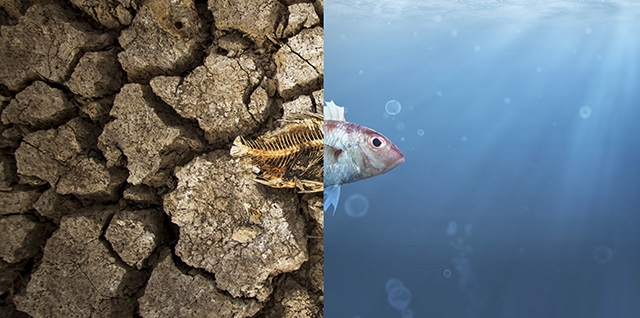A changing planet
氣候變化削減海洋物種多樣性
Ever since Earth formed roughly 4.5 billion years ago, its climate has gone through a number of incredible changes.
地球形成至今已有約45億年,在這期間,地球氣候經歷了諸多令人難以置信的變化。
All you have to do is look at images of the Jurassic Period to know that at one time, much of our planet was covered in extremely hot and humid jungle. Skip ahead a couple million years and you get to an ice age event, when global temperature experienced a huge drop. While many species were not able to deal with these changing climate patterns, others successfully adapted, and some are even still with us today.
你只要看看侏羅紀時期的照片,就會知道曾經地球大部分地區都極其炎熱潮濕、叢林密布。向前跳轉幾百年,你會進入冰河時期,當時全球氣溫經歷了一次驟降。雖然許多物種無法應對這些變化的氣候模式,但是有些物種成功適應,甚至存活至今。
Now, as humanity pushes the planet closer to another extreme climate event, scientists are eager to find out how the world’s species will react.
現在,隨著人類將地球推向另一個極端性氣候事件,科學家們急于發現地球物種將作何反應。

The idea was highlighted in a study published on April 6 in the journal PNAS, which showed that between 1970 and 2010, open water species such as lobsters and fish had declined by about half in tropical marine zones across the globe because over the 40-year time period, sea temperatures in those regions had risen by roughly 0.2 C.
發表在4月6日《美國科學院院報》上的一項研究強調了這一觀點。該研究顯示,在1970年至2010年間,全球熱帶海洋地區開放水域中的龍蝦、魚類等物種總數減少近一半,原因是過去40年內,這些地區的海水溫度上升了將近0.2攝氏度。
The lower numbers aren’t a sign of all the sea creatures dying off though. In fact, the scientists found some of them outside of their traditional habitats, meaning that if a species can migrate to cooler waters and adapt in a new environment, they will.
不過,數量減少并不代表所有海洋生物都將滅絕。實際上,科學家發現,有些生物離開了原本的棲息地,這意味著如果一些物種可以遷移到較冷的水域,適應新的環境,他們就會這么做。
However, those movements aren’t always a good thing; species that can’t move, such as coral, which is fixed to the seabed, rely on the fish and other sea creatures to contribute to the natural food chain and stay healthy. Additionally, when a non-native species moves into a new area, it threatens to disrupt the ecosystem that already exists there.
然而,這些遷移并不總是一件好事;不能遷移的物種,比如固定在海底的珊瑚蟲,依靠魚類和其他海洋生物,形成天然的食物鏈,從而健康生存。此外,外來物種遷移至新地方,可能擾亂原本的生態系統。
Depending on the species, it can take anywhere from one generation to thousands and thousands of years to properly adapt, so the changes that have occurred in just the last 40 years are very troubling for scientists. As Sebastian Ferse, an ecologist at the Leibniz Centre for Tropical Marine Research, Germany, explained: “In geological history, this has occurred in the blink (眨眼) of an eye. To see such changes occurring so rapidly is something quite alarming.” He added, “One of the big questions is ‘Will coral reefs as ecosystems and corals as species be able to move north or south fast enough to adjust to a changing climate?’”
對這些物種而言,真正適應新環境可能需要經歷一代甚至千萬年,所以近40年出現的這些變化令科學家感到十分困擾。正如德國萊布尼茨熱帶海洋研究所生態學家塞巴斯蒂安·弗澤解釋的,“在地質歷史中,這發生在眨眼之間。看到如此迅速的變化,真的令人擔憂。”他補充道,“其中一個大問題是,‘作為生態系統的珊瑚礁和作為物種的珊瑚能夠快速向北或向南遷移以適應變化的氣候嗎?’”












